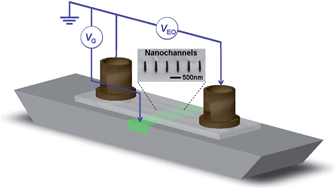The interactions between charged molecules and channel surfaces are expected to significantly influence the electrokinetic transport of molecules and their separations in nanochannels. This study reports the effect of wall–molecule interactions on flow control of negatively charged Alexa 488 and positively charged Rhodamine B dye molecules in an array of nanochannels (100 nm w × 500 nm d × 14 mm l) embedded in fluidic field effect transistors (FETs). For FET flow control, a third electrical potential, known as a gate bias, is applied to the channel walls to manipulate their ζ-potential. Electroosmotic flow of charged dye molecules is accelerated or reversed according to the polarity and magnitude of the gate bias. During FET flow control, we monitor how the electrostatic interaction between charged dye molecules and channel walls affects the apparent velocity of molecules, using laser-scanning confocal fluorescence microscopy. We observe that the changes in flow speed and direction of negatively charged Alexa 488 is much more pronounced than that of positively charged Rhodamine B in response to the gate bias that causes either repulsive or attractive electrostatic interactions. This observation is supported by calculations of concentration-weighted velocity profiles of the two dye molecules during FET flow control. The velocity profile of negatively charged Alexa 488 is much more pronounced at the center of each nanochannel than near its walls since Alexa 488 molecules are repelled from negatively charged channel walls. This pronounced center velocity further responds to the gate bias, increasing the average velocity by as much as 23% when −30 V is applied to the gate (ζ-potential = −80.6 mV). In contrast, the velocity profile of positively charged Rhodamine B is dispersed over the entire channel width due to dye–wall attraction and adsorption. Our experimental observations and calculations support the hypothesis that valence-charge-dependent electrostatic interaction and its manipulation by the gate bias would enhance molecular separations of differentially charged molecules in nanofluidic FETs.

You have access to this article
 Please wait while we load your content...
Something went wrong. Try again?
Please wait while we load your content...
Something went wrong. Try again?


 Please wait while we load your content...
Please wait while we load your content...